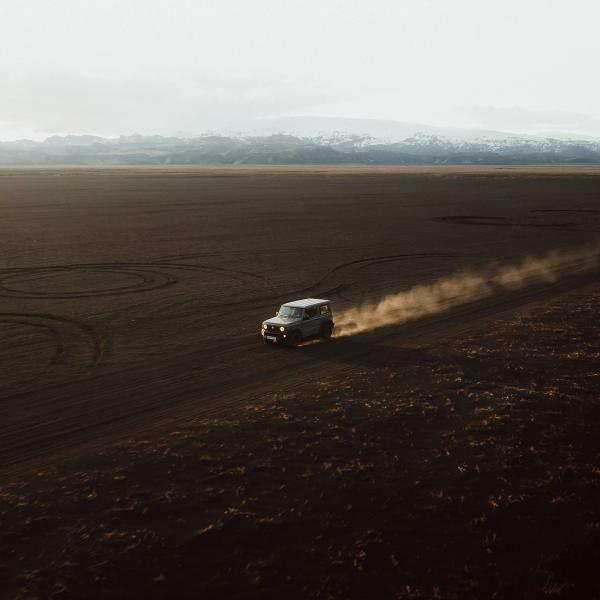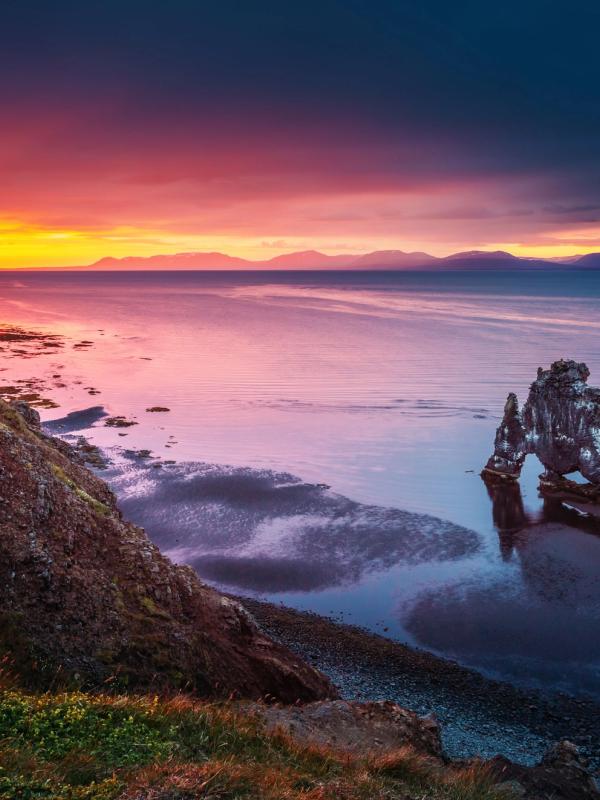
Hvitserkur: The Dragon Rock of Iceland
Iceland is a land full of outstanding natural monuments. Places that look like no other and that can’t be found almost anywhere else in the world. Here, nature is shown in many different ways due to the different natural forces that come into play. Among the many wonders this country has, some landmarks seem to have leaped straight from a fantasy story. Peculiar places and formations that have also inspired tales and legends. One of these is Hvitserkur, a majestic rock formation in the middle of the sea in North Iceland. Often referred to as the "drinking dragon" for its unique silhouette, Hvitserkur is not only a natural masterpiece but also a symbol of Iceland's deep connection between local folklore and its rugged landscapes.
When people come to Hvitserkur, they do it not only to see a rock but to immerse themselves in a world where geology and mythology connect. This unique basalt formation, shaped by volcanic forces and eroded by the action of the waves over the centuries, stands as a testament to Iceland’s dynamic natural history. With the high and low tides, the rock shows its different sides, making it a favorite for tourists and photographers alike. If you’re looking for a place that offers beauty, legend, and tranquility, then you have to see Hvitserkur.
Key Takeaways
- Hvitserkur is a big rock formation located in Vatnsnes Peninsula, in the region of Norðurland Vestra, in North Iceland.
- Its unique shape resembles a dragon, a dinosaur, a rhino, or a troll, as all these things are what people claim they see.
- Hvitserkur is also a sanctuary for wildlife, with large colonies of seals and hundreds of sea birds.
What's Hvitserkur?
The answer to that question can be tricky, as this place is something different depending on who’s looking at it. But let’s start with the facts. Hvitserkur is a 15-meter-tall basalt sea stack standing in the waters, in front of the eastern shore of the Vatnsnes Peninsula. This area is part of Norðurland Vestra, also called the Northwestern region in English, one of the eight regions that make up Iceland.
Hvitserkur's jagged and peculiar shape has sparked imaginations for generations. From certain angles, it looks like a dragon leaning down to drink from the ocean. However, it doesn’t look the same to everyone. Some people claim to see a dinosaur frozen in time, while others say it’s an elephant or even a rhino. But Hvitserkur isn’t just about appearances—it’s a geological marvel with a fascinating story.
This unique geological feature was formed millions of years ago due to volcanic activity. Originally, Hvitserkur was part of a larger cliff that has been eroded by the relentless forces of the wind and the waves, leaving behind the basalt structure we see today. To prevent further erosion and the eventual loss of this natural monument, concrete was poured into its base during the 20th century, ensuring that this place continues to exist. This is also because it’s not only a feast for the eyes but also a place where many seabirds, like fulmars and gulls, live. Many of these birds nest in the crevices and ledges that exist in the formation. In fact, the name means “white shirt” in Icelandic due to all the bird droppings that streak its surface.
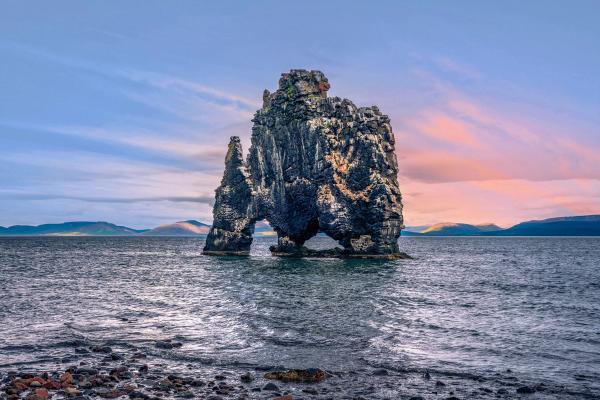
Folklore of Hvitserkur
Icelandic folklore has countless stories of trolls, elves, and other mythical beings. They are supposed to live in different natural places and landmarks, in places where humans can’t bother them. And, of course, Hvitserkur’s story is no exception. According to legend, the rock was once a troll who roamed the coasts in North Iceland. He was particularly annoyed by the construction of a church on the Vatnsnes Peninsula and especially the sound of the bells. He then decided to destroy it by throwing a massive boulder. However, he miscalculated the time of the day, and the first light of dawn caught him off guard. Caught in the sunlight, the troll was turned to stone, frozen forever.
This story is just one example of how Icelandic culture uses mythology to understand the natural world. These tales are not only entertainment. In the past, they were used to explain things people could not understand, like the immense natural forces that shape our world. Standing before Hvitserkur, it’s easy to imagine the troll turned into stone, like a guardian who protects the land from dangers from the sea.
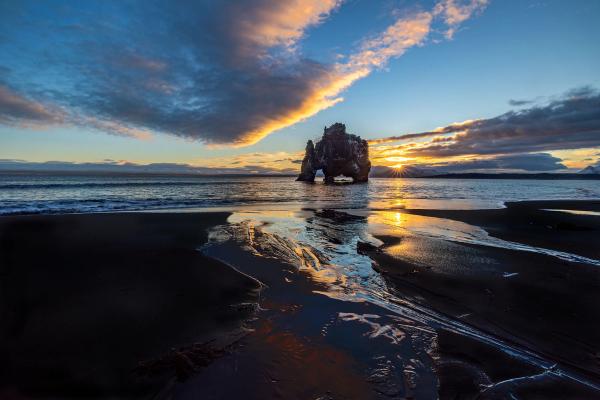
Where's Hvitserkur and How to Get There?
Hvitserkur is located on the eastern shore of the Vatnsnes Peninsula in North Iceland. It’s approximately 223 kilometers (138 miles) away from Reykjavik and 120 kilometers (75 miles) from Akureyri, Iceland’s second-largest city and the main city in the north of the country. Despite its remote location, the journey to this remarkable site is an adventure in itself. Along the way, you can enjoy astonishing landscapes. You can plan your visit to Hvitserkur as part of a larger route.
We’ll explain how to get there from both Reykjavik and Akureyri. The best way to get to Hvitserkur and to move around Iceland in general is by car.
From Reykjavik, the drive takes about 3 hours. Head north on the Ring Road (Route 1), Iceland’s main highway. After about 200 kilometers (125 miles), turn onto Route 711, which takes you straight to Hvitserkur. You can also find an alternative route for a more scenic itinerary. 10 kilometers before the exit for Route 711, you’ll come across the exit for Route 72, which will take you to the town of Hvammstangi. This charming village is a great place to stop, with its cozy cafés and the Icelandic Seal Center, where you can learn about the area’s wildlife. From Hvammstangi, continue on Route 711, a gravel road that loops around the Vatnsnes Peninsula, before arriving at Hvitserkur.
If you’re coming from Akureyri, the journey is a bit shorter, taking around two and a half hours. Follow the Ring Road westbound toward Varmahlíð. From there, Continue on Route 1 until you see the exit for Route 716. After a short stretch, you can take Route 711, as in the itinerary explained before.
What to See and Do Near Hvitserkur
Hvitserkur is such an outstanding natural monument that it is a destination in itself. However, several things nearby can enhance the visit.
Seal Watching
The Vatnsnes Peninsula is one of the best places in Iceland to see seals in their natural habitat. Illugastadir, a short drive from Hvitserkur, offers excellent opportunities to watch these curious creatures lounging on the rocks or playfully swimming near the shore. The area has several walking paths and designated viewing areas, so it’s easy to enjoy the wildlife without disturbing it. This area is especially magical if you’re into photography, providing many opportunities to capture unforgettable moments.
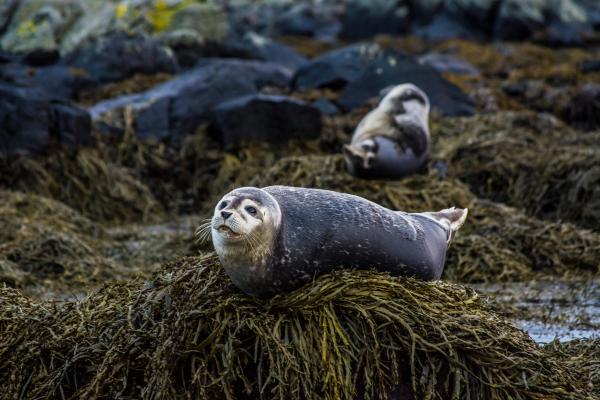
Hvammstangi
Hvammstangi, often called the seal-watching capital of Iceland, is a nice little town that is the most important urban area in the Vatnsnes Peninsula. It’s home to the Icelandic Seal Center, where you can learn about the history and biology of Iceland’s seal populations. The town also has a good number of nice cafés, local handicraft shops, and the views of the coast are fantastic.
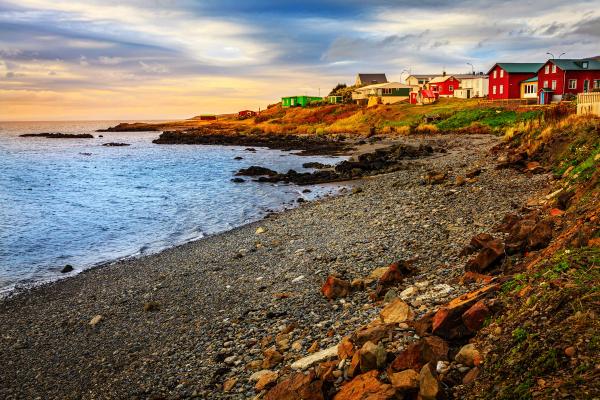
Kolugljúfur Canyon
About an hour from Hvitserkur, Kolugljúfur Canyon is a great geological feature carved by the Víðidalsá River. The canyon has tall and dramatic cliffs and several waterfalls, including the stunning Kolufossar falls. The area has several short hiking trails to explore the beauty of this place from up close.
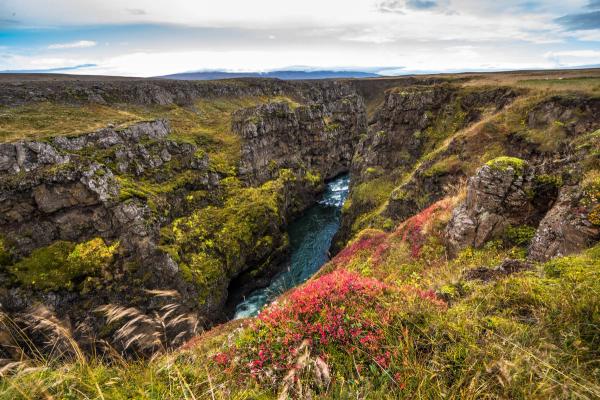
Skagafjörður
Iceland is home to some of the most beautiful and dramatic fjords in the world. They come in different shapes and sizes, and they are mostly located in the north and east of the country. Skagafjörður is a picturesque fjord not far from Hvitserkur, featuring wide valleys and beautiful mountains. It’s also one to get in touch with one of the most beloved animals on the island: the Icelandic horse. There are tours available where visitors can ride these friendly and noble creatures. This area is also a great spot to enjoy river drafting.
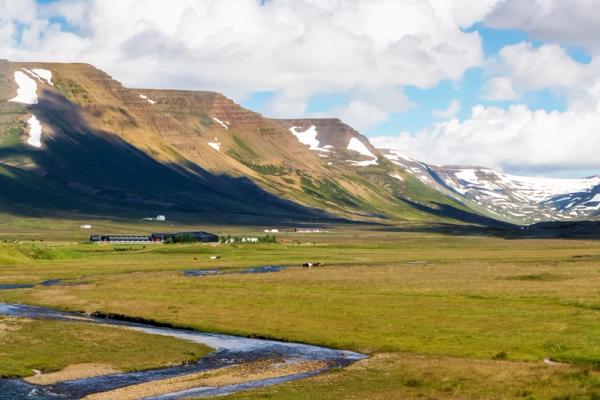
Grettir’s Pool
A trip to Iceland would be considered incomplete if it doesn’t include a geothermal bath. There are many hot springs and spas all over the country where both locals and tourists go to wind down and socialize. Near Skagafjörður, we can find Grettir’s Pool -Grettislaug in Icelandic- a natural geothermal hot spring named after Grettir the Strong, a legendary character from the Icelandic sagas. In this pool, one can enjoy a relaxing soak with spectacular views of the surrounding mountains and fjords. It’s the perfect way to finish a day exploring the region.
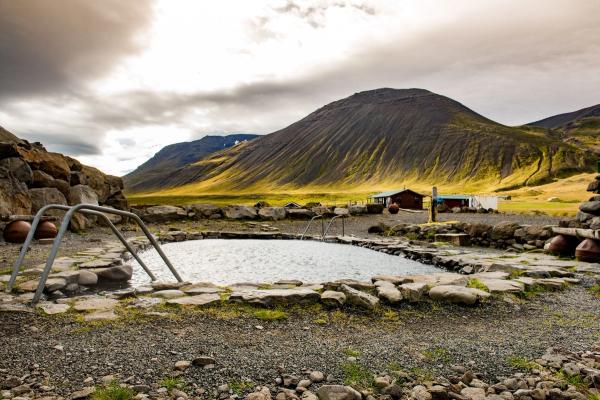
Photography at Hvitserkur
The singular shape of Hvitserkur creates a majestic backdrop for photography. It’s a photographer’s dream offering different compositions at certain times of the day. When the tide is low, you can walk closer to the rock and capture its intricate details. The best moments are probably sunrise and sunset, where the light adds textures and contrasts to the scene. In winter, this place gets even more spectacular under the Northern Lights.
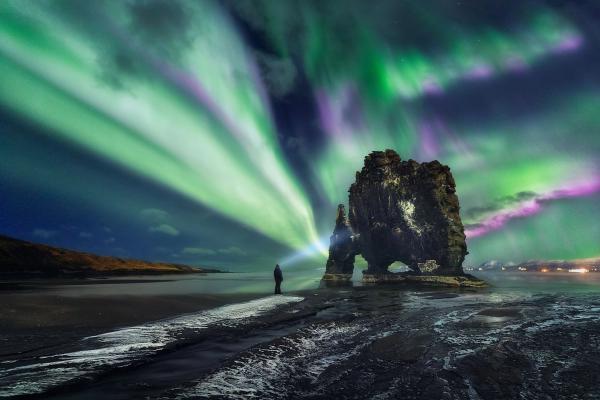
The Weather in Hvitserkur
Iceland’s weather is famously unpredictable, and Hvitserkur’s location on the coast adds another layer of variability. Here’s what to expect season by season:
Spring (April May)
Spring is a time of transition, with temperatures ranging from 0°C to 10°C (32°F to 50°F). Snow begins to melt, and the landscape comes alive with flowers and green fields. The weather can still be chilly and windy, but the days get longer by the week.
Summer (June to August)
This is the warmest and busiest season, with temperatures averaging between 10°C and 15°C (50°F to 59°F). The days are very long, with almost 24 hours of natural light by the end of June, giving plenty of time for exploring outdoors. Summer is also the best time for seal watching.
Autumn (September and October)
This is another transitional period, with cooler temperatures and shorter days. The average temperature moves between -2°C to 8°C (28°F to 46°F). It’s essential to be prepared for sudden rain and wind, but the north is drier than South Iceland. By October, there are chances to see the Northern Lights.
Winter (November to March)
Winter transforms Hvitserkur into a Christmas postcard. It’s cold, with temperatures often below freezing. On the other hand, it’s the time of the year with the most chances to see the Northern Lights. Roads can be covered in ice and difficult to drive on, so a 4x4 vehicle and careful planning are essential.
Travel Tips
Follow these tips to make the most of your visit to Hvitserkur.
- Photography: Bring a tripod to adapt to different light conditions, especially if you’re capturing the Northern Lights or sunrise.
- Driving: Rent a 4x4 vehicle, particularly in winter, and check the weather forecast and the road conditions before setting out.
- Pack essentials: Dressing in layers is the best way to adapt to the constantly changing Icelandic weather. For the outer layer, use waterproof and windproof clothes, along with sturdy hiking boots.
- Low tide: Plan your visit during low tide to get closer to the rock and explore the shoreline.
- Don’t disturb the wildlife: Keep a respectful distance from seals and nesting birds, and avoid making loud noises that might disturb them.
- Snacks and water: There are no facilities near Hvitserkur, so pack snacks, water, and anything else you might need for your visit.
- Respect the Environment: Iceland’s natural beauty is fragile. Stick to marked paths, take your trash with you, and leave no trace behind.
Conclusion
Hvitserkur is a place where geology, mythology, and Icelandic beauty meet. Its unique shape and beautiful surroundings make it a must-visit destination if you’re exploring North Iceland. This formation is one of the best places in the country for photography, and even though it’s a bit remote, it’s totally worth the trip.

